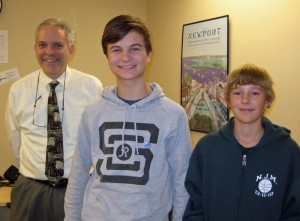CHS TV production thrives with support from CAPE
By Ruth WeinerEditor’s note: Below is the third in an ongoing series of articles highlighting innovative education programs that have been made possible by a grant from the Canton Alliance for Public Education (CAPE), a non-profit, community-based foundation whose mission is to “promote innovative and productive programs that challenge students and teachers to achieve their true potential.”
With cameras rolling, the television production crew at Canton High School no longer worries that the tape will break or the image will be corrupted. Thanks to a generous grant from the Canton Alliance for Public Education, TV production teacher Ed McDonough was able to purchase six new camcorders that use secure digital memory cards.
McDonough’s students produce a wide variety of programming for the student station that serves the entire town, including interview shows as well as sporting and cultural events.
“Our stock was not intended for heavy daily use and they were three years old,” said McDonough, who is also the cable access coordinator for the schools. “Without money allotted for camcorders, the television production program was in a predicament. Having the CAPE grant made all the difference in the world.”
Senior Dan Sheehy, lead producer of the student station, welcomed the new equipment. “Last year, we were frustrated reusing tapes in the cameras,” he said. “There were blinds and frozen images and lines from old videos. It was a pain in the neck. We might have gotten something great, but there was nothing we could do about it.”
The new cameras and SD memory cards eliminate the problem. “With technology changing rapidly, it’s hard to keep current,” said Sheehy, who has helped transition the studio from adult-operated to student-run. “It’s all about learning. Every time we go out, we discover something new.”
Enthusiastic freshman Mike Noone wants to be a director when he is older. To cover a volleyball game or interview a coach, he signs out a camera and an SD card, then gets the footage. He returns to the studio for editing, and within hours, a professional product is “good to go.”
This was not always the case. “Basically, we’re now looking at two hours, not a week’s turn around,” said Sheehy.
With McDonough as their silent partner, students learn to “communicate using a visual message.” In addition to sports and community events, the student station presents public service announcements, described by McDonough as “compelling messages expressing ideas clearly and persuasively — a key component of the common core standards.”
McDonough emphasizes how 21st century skills are acquired through his curriculum. “We use technology to communicate effectively,” he said. “The program is beneficial to all students, giving them experience and developing the acuity needed for success in any endeavor.”
McDonough encourages all students to participate. In senior Morgan McIsaac’s college application, she writes, “Mr. McDonough presented me with an extraordinary opportunity. Public television gave me the confidence I needed to truly thrive.”
Many CHS students have gone on to successful careers in the field of communications. They got their start in McDonough’s studio. An energetic, dedicated teacher, he invests countless hours overseeing production, believing passionately in the lasting power of video.
“If a picture says a thousand words, and one second of video has 30 frames or pictures, a 30-minute video says 54,000,000 words,” noted McDonough. “I’d say that is quite an impact considering we archive these programs for future generations to enjoy — and the wonderful grant from CAPE makes continuing this work possible.”
Short URL: https://www.thecantoncitizen.com/?p=17613











